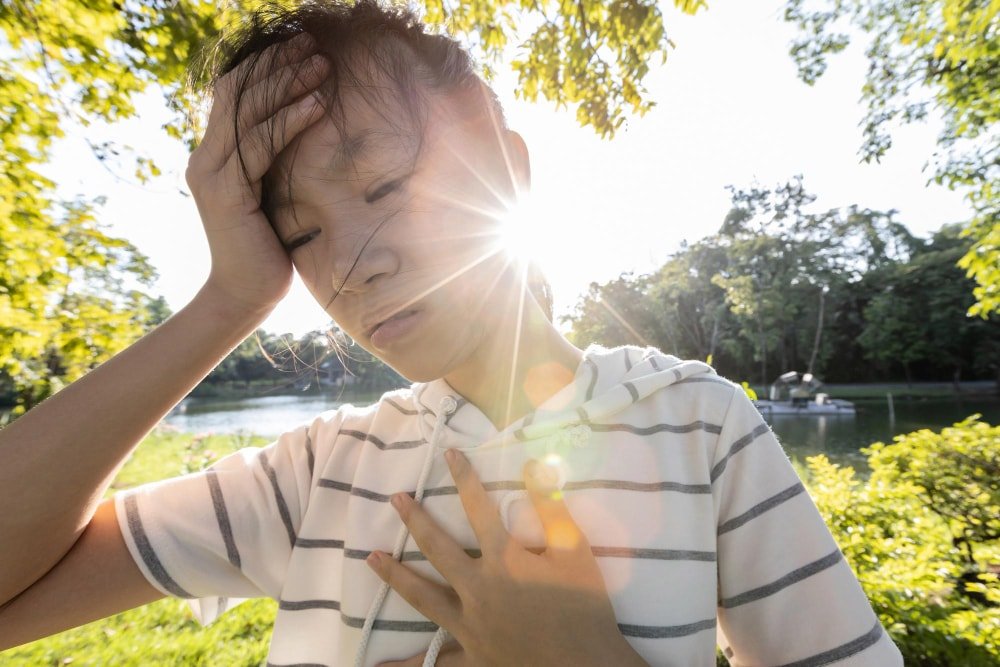Heat exhaustion in children is a prevalent and dangerous condition that parents need to understand. This guide will demystify its symptoms, causes, and prevention. By following this guide, you will be better equipped to recognize and respond to heat-related illnesses.
What is Heat Exhaustion in Children?
Heat exhaustion is a heat-related illness resulting from prolonged exposure to high temperatures. It often occurs during outdoor activities in hot weather, leading to serious health issues.
Definition of Heat Exhaustion
- Heat exhaustion is a condition characterized by heavy sweating, rapid pulse, and other symptoms resulting from the body overheating.
- It happens when the body loses water and salt through perspiration, leading to a decrease in blood volume.
Difference Between Heat Exhaustion and Heat Stroke
- Heat exhaustion involves symptoms like heavy sweating, weakness, and dizziness, but it is less severe.
- Heat stroke is a life-threatening emergency where the body temperature exceeds 104°F (40°C), causing potential brain damage and requiring immediate medical attention.
Understanding these distinctions helps in taking timely and appropriate actions to safeguard children from severe heat illnesses.
Symptoms of Heat Exhaustion in Children
Recognizing the symptoms of heat exhaustion is critical for early intervention. Parents should be vigilant, especially during hot weather and physical activity.
Common Symptoms
- Heavy sweating: Excessive perspiration is one of the early warning signs.
- Pale, clammy skin: Indicates the body is struggling to cool down.
- Fatigue: The child might feel unusually tired or weak.
- Nausea or vomiting: An upset stomach can accompany heat exhaustion.
- Headache: Often a result of dehydration and overheating.
- Muscle cramps: Painful muscle cramps or heat cramps can occur due to loss of salt.
- Dizziness or lightheadedness: The child may feel dizzy or faint.
When to Seek Medical Help
- Persistent symptoms: If symptoms don’t improve after taking initial cooling measures.
- High body temperature: If the body temperature does not drop or stays high.
- Confusion or altered mental state: Signifies a more serious heat-related illness.
- Loss of consciousness: Immediate medical attention is required.
- Rapid pulse: A quick heartbeat may point to severe heat stress.
Understanding and recognizing these symptoms can prevent heat exhaustion from progressing to a more severe form, such as heat stroke. Always err on the side of caution and seek medical attention if unsure.
Causes of Heat Exhaustion in Children
Understanding the causes of heat exhaustion in children is essential for prevention. Several factors can increase the risk of developing this heat-related illness.
Environmental Factors
- High temperatures: Prolonged exposure to high temperatures can overwhelm the body’s cooling mechanisms.
- High humidity: It hampers sweat evaporation, reducing the body’s ability to lose heat effectively.
- Hot weather: Common during summer, leading to increased heat exposure.
Physical Activity and Heat
- Intense exercise: Physical activity in hot environments causes the body to generate more heat.
- Excess clothing: Wearing too many or inappropriate clothes can trap heat, preventing cooling.
- Inadequate hydration: Failing to drink enough fluids before, during, and after activities can lead to dehydration and heat exhaustion.
- Outdoor activities: Extended periods spent outside without adequate breaks in cooler places or access to shade.
By understanding these causes, parents can take proactive steps to prevent heat exhaustion in children. Monitoring environmental conditions and ensuring proper hydration and dressing can significantly decrease the risk.
Prevention and Management of Heat Exhaustion in Children
Preventing and managing heat exhaustion in children involves proactive steps and immediate actions during high-heat conditions.
Preventive Measures
- Stay hydrated: Ensure children drink lots of water all day, especially in hot weather.
- Appropriate clothing: Dress children in light-colored, loose-fitting clothing to facilitate air circulation and reduce heat build-up.
- Limit outdoor activities: Plan outdoor activities during cooler parts of the day, like early morning or late afternoon.
- Use sunscreen: Protect the child’s skin from sunburn, which hinders the body’s ability to cool down.
- Regular rest periods: Ensure kids take frequent breaks in cool places during intense activities.
Immediate Actions to Take
- Move to a cooler place: Relocate the child to a shaded area or an air-conditioned environment as soon as symptoms appear.
- Hydration: Offer cool water or sports drinks to replenish lost fluids and electrolytes.
- Cooling techniques: Apply cool clothes or a cool bath to lower body temperature.
- Remove excess clothing: Take off any unnecessary or tight clothing to help the body lose heat more efficiently.
Recovery Steps and Timeline
- Rest: Ensure the child gets adequate rest to recover from heat exhaustion.
- Monitor symptoms: Keep an eye on the child’s symptoms for any signs of worsening conditions.
- Gradual reintroduction: Slowly reintroduce the child to physical activities as they recover to prevent relapse.
- Seek medical attention: If symptoms persist or worsen, consult a healthcare professional for further treatment.
Implementing these preventive measures and management steps can effectively keep children safe from heat exhaustion and other heat-related illnesses.
How Long Does Heat Exhaustion Take to Recover From?
Recovery from heat exhaustion varies depending on the severity and the timeliness of the interventions.
Typical Recovery Time
- Mild cases: Children can recover within a few hours after being moved to a cooler place, rehydrating, and resting.
- Moderate cases: It may take a day or two for full recovery, ensuring they are monitored for any persistent symptoms.
Factors Affecting Recovery
Several factors can influence the recovery time from heat exhaustion:
- Severity of symptoms: More severe symptoms may require longer recovery periods.
- Timeliness of intervention: Quick actions to cool the child and rehydrate can shorten recovery time.
- Overall health: Children with preexisting health conditions may take longer to recover.
- Environmental conditions: Prolonged exposure to high temperatures can necessitate more extended recovery.
Long-Term Precautions
- Avoid high heat: Limit exposure to extreme heat, especially during recovery.
- Stay hydrated: Encourage ongoing hydration even after symptoms subside.
- Monitor for relapse: Watch for any recurring symptoms of heat exhaustion.
- Educate on prevention: Teach children the importance of staying cool and hydrated during hot weather.
Understanding these recovery dynamics ensures that children receive the proper care needed to fully recuperate from heat exhaustion while minimizing the risk of recurrence.
Final Thoughts
Proper knowledge and proactive steps can significantly reduce the risk of heat exhaustion in children. Early recognition and immediate action are key to preventing further complications.
Summary of Key Points
- Understand the condition: Knowing what heat exhaustion is and its symptoms can lead to timely intervention.
- Recognize symptoms: Vigilantly watching for signs such as heavy sweating, fatigue, dizziness, and muscle cramps can prevent escalation.
- Identify causes: Awareness of environmental factors and the impact of physical activity is crucial.
- Implement preventive steps: Hydration, appropriate clothing, and limiting outdoor activities are essential preventive measures.
Importance of Awareness
- Education: Inform children and caregivers about the risks and prevention strategies.
- Preparedness: Equip yourself with the knowledge to handle heat-related illnesses.
- Community support: Share this information to enhance community awareness and safety.
Encourage a proactive approach to dealing with heat exhaustion and other heat-related illnesses. Parents and caregivers play a critical role in safeguarding children’s health during high temperatures. For further information and resources, consult healthcare professionals.



